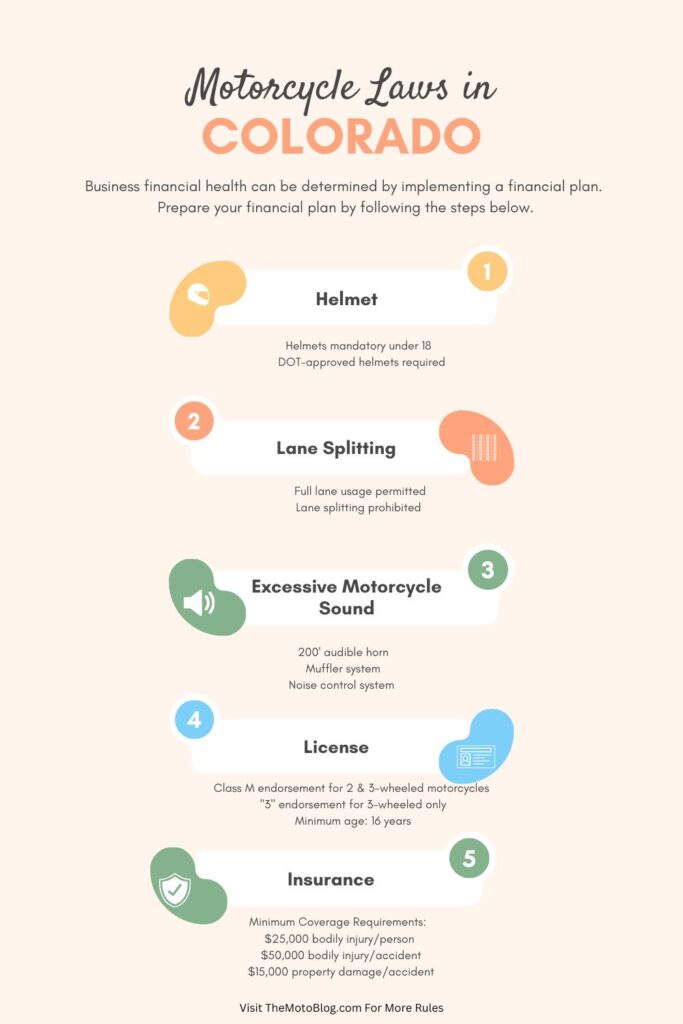Motorcycle Laws in Colorado: An Expert’s Guide to Navigating the Rockies Safely
Colorado’s motorcycle regulations reflect a balanced approach between rider freedom and safety, situated uniquely among its neighboring states. Riders coming from Utah will notice similar helmet laws, while those from Kansas and Nebraska will find Colorado’s regulations more lenient. The state’s diverse terrain, from the Rocky Mountains to eastern plains, demands specific safety considerations that shape these laws. Wyoming and New Mexico share similar geographical challenges, leading to comparable regulatory frameworks.

| Category | Requirements |
|---|---|
| Licensing | • Class M endorsement for 2 & 3-wheeled motorcycles • “3” endorsement for 3-wheeled only • Minimum age: 16 years • Written exam + skills test OR MOST course • Valid Colorado driver’s license required • 12-month permit hold for under 18 |
| Helmet and Safety Equipment | • Helmets mandatory under 18 • DOT-approved helmets required • Eye protection mandatory for all • Additional protective gear optional |
| Operating Rules | • Full lane usage permitted • Lane splitting prohibited • 1-2 headlamps required • Red tail lamp (20-72″ from ground) • Stop lamp for post-1958 bikes • One mirror with 200′ rear view • Mandatory footrests |
| Insurance | • $25,000 bodily injury/person • $50,000 bodily injury/accident • $15,000 property damage/accident |
| Vehicle Requirements | • Working brakes on ≥1 wheel • 200′ audible horn • Muffler system • DOT-approved tires • Noise control system |
| Passenger Rules | • No minimum age • Mandatory footrests • Designated passenger seat • Must ride behind driver/in sidecar • Helmet if under 18 • Eye protection mandatory |
| Registration | • 90 days for new residents • 60 days after purchase • Colorado address required • Proof of insurance • Proof of ownership • Valid ID |
| Traffic Laws | • Standard vehicle laws apply • Proper parking required • Two bikes may share lane • Highway rules same as cars |
| Penalties | • 1st offense: $500, 4 points • 2nd offense: $1,000 + suspension • 3rd offense: $1,000 min, 8-month suspension |
Licensing Requirements
To legally operate a motorcycle in Colorado, riders must obtain proper licensing through the state’s graduated system. The Class M endorsement covers both two and three-wheeled motorcycles, while a “3” endorsement is specifically for three-wheeled vehicles.
Getting Your License
The licensing process involves either completing a written exam and skills test or finishing the Motorcycle Operator Safety Training (MOST) course. New riders must be at least 16 years old and provide a valid Colorado driver’s license and identity proof.
Instruction Permits
Young riders under 18 must hold their instruction permit for 12 months before obtaining a full license, ensuring adequate preparation time for safe riding.
Safety Equipment Requirements
Helmet Laws
Colorado’s helmet laws are age-based:
- Mandatory for riders under 18
- Optional for riders 18 and older
- All helmets must meet DOT certification standards
Additional Safety Gear
Eye protection is mandatory for all riders and passengers, regardless of age. While additional protective gear is recommended, it’s not legally required beyond eye protection.
Operating Regulations
Motorcyclists must follow specific operational rules:
- Full lane usage rights
- Lane splitting is prohibited
- Mandatory lighting requirements including headlamps and tail lamps
- At least one mirror providing 200-foot rear visibility
- Required footrests for both rider and passenger
Insurance Requirements
All motorcyclists must maintain minimum insurance coverage:
- $25,000 bodily injury per person
- $50,000 bodily injury per accident
- $15,000 property damage per accident
Vehicle Specifications
Motorcycles must meet basic equipment requirements:
- Functional brakes
- Horn audible from 200 feet
- Proper muffler system
- DOT-approved tires
Passenger Regulations
Passenger safety requirements include:
- Mandatory footrests
- Designated passenger seating
- Position behind driver or in sidecar
- Eye protection for all passengers
- Helmets for those under 18
Registration Requirements
New residents and purchasers must complete registration:
- Within 90 days of establishing residency
- Within 60 days of purchase
- Must provide proof of insurance and ownership
Traffic Laws and Enforcement
Standard traffic laws apply with specific provisions:
- Two motorcycles may share a lane
- Proper parking positioning
- Insurance violation penalties ranging from $500 to $1,000
Understanding Colorado’s motorcycle laws is crucial for both residents and visitors exploring the state’s scenic routes. While Arizona riders may find similarities in the climate considerations, those from Oklahoma should note the different approach to helmet requirements. Whether you’re planning a cross-state journey through the Rockies or settling in Colorado as a resident rider, these regulations ensure both freedom and safety on the open road. The state’s commitment to motorcycle safety while maintaining rider autonomy makes it a premier destination for motorcycle enthusiasts throughout the region.
Motorcycle Laws in the US By States
If you liked this article, then please subscribe to our YouTube Channel for more Bike Videos. You can also find us on Instagram, Twitter and Facebook.
Disclosure: As an Amazon Associate, I earn from qualifying purchases. Read more about Amazon Affiliate Disclaimer.

Vishwanath Mathpati
I am Vishwanath Mathpati, a full-time Blogger and Motorcyclist from Bidar, Karnataka. I love writing about my Motorcycles Stories and Riding Gears on this blog.
Know More About Me.







